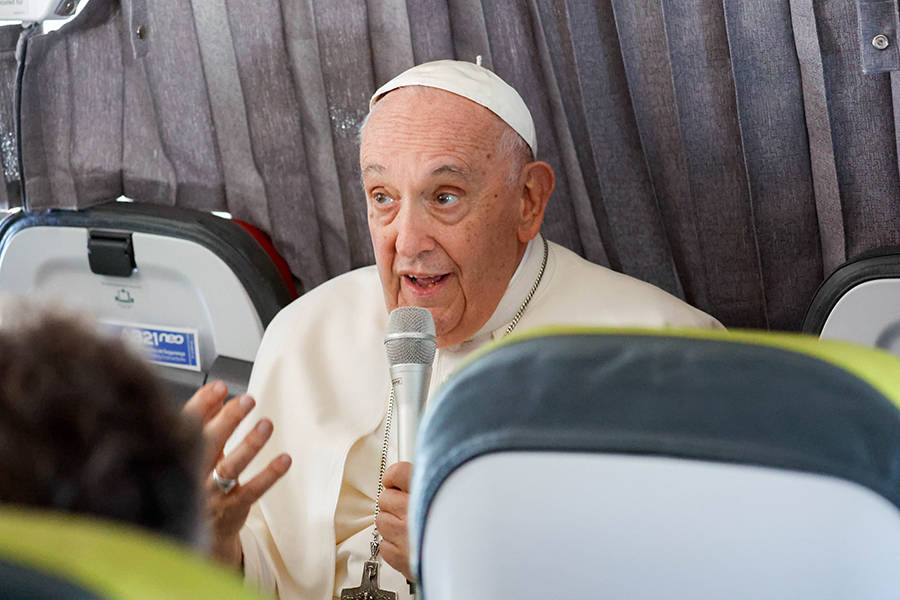
PROSPECT HEIGHTS — A new report has found that Pope Francis’ favorability rating among American Catholics has fallen from 83% in 2021 to 75% in 2024, with those who view the pontiff unfavorably also saying he represents a change in the direction of the Church.
The nation’s ever-growing partisan divide is at the heart of Pope Francis’ favorability drop. Survey data shows that the partisan gap of views of Pope Francis are as large as ever, with Democrats giving the pontiff a favorability rating of 89%, and Republicans giving him a favorability rating of 63%.
“The overall drop in favorability reflects growing dissatisfaction with the current pope among Catholics who identify as Republicans or Independents who lean towards the Republican Party,” concludes the survey conducted by the Pew Research Center.
Pew’s survey was published April 12 and explores American Catholics’ view of Pope Francis and the Church. It’s the 14th such survey the organization has conducted during Pope Francis’ pontificate, and the 22nd one overall. It was conducted five times during the pontificate of Pope Benedict XVI, and three times during the pontificate of Pope St. John Paul II.
To gather the data for the latest iteration, Pew surveyed 2,019 Catholics from Feb. 13-25. Seven in 10 U.S. Catholic respondents also said Pope Francis represents either a major or minor change in the direction of the Church. It is largely those who view him unfavorably that have this belief.
Across the 14 surveys of this kind conducted during Pope Francis’ pontificate, his average favorability rating is about 82%, which is about his rating over the past three years. His lowest favorability rating was 72% in September 2018, and his highest favorability rating was 90% in February 2015.
Pope Francis’ favorability ratings sandwich him in between Pope St. John Paul II and Pope Benedict XVI.
Pope Francis’ highest favorability rating is lower than St. John Paul’s lowest favorability rating. Pew conducted the survey during St. John Paul’s pontificate in 1987, 1990, and 1996, and his favorability ratings for those years were 91%, 93%, and 93%, respectively.
Pope Francis consistently, however, has had higher favorability ratings than Pope Benedict. Pew conducted the same survey during Benedict’s pontificate in 2005, 2007, twice in 2008, and 2013, and his favorability ratings for those years were 67%, 74%, 74%, 83%, 74%, respectively.
With Pope Francis’ ratings in particular, a look back at the partisan splits over the years shows just how much each faction has changed their views of the pontiff. When this survey was first conducted on Pope Francis in March 2013, Republicans actually had a more favorable view of Pope Francis than Democrats, giving him an 84% favorability rating. Democrats, meanwhile, gave him a favorability rating of 77%.
Unlike with views of Pope Francis, there wasn’t a huge partisan divide on American Catholics’ support for a number of would-be drastic changes to the Church. Across ideological lines, the survey found that American Catholics want the Church to allow the use of contraception (83%), to allow priests to get married (69%), and to allow women to become priests (64%).
All of these issues received support from both the so-called left and right. In each case the support was overall higher among Democrats who for the most part said they seldom or never attend Mass, compared to Republicans who largely said they attend Mass at least once a week.
The survey also found American Catholics want the Church to recognize the marriages of gay and lesbian couples. With this topic, however, there was a drastic partisan divide. The survey data shows that the change is supported by 72% of American Catholics who are Democrats but supported by only 36% of American Catholics who are Republicans.
When compared to survey results from about a decade ago the survey results represent a slight increase in the number of American Catholics who support the Church allowing birth control. Meanwhile, the number of American Catholics who support the Church allowing priests to get married, allowing women to become priests, and recognizing the marriages of gay and lesbian couples is about the same.
In essence, the survey shows that American Catholics continue to support changes to Church customs.
